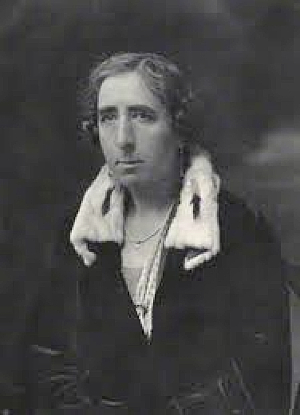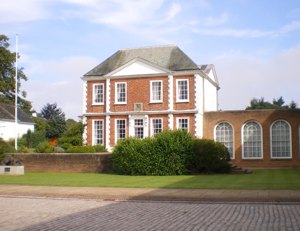
Audrey Charlotte Georgiana Buller
Written and researched by Julia Sharp
Page added 4th December 2012
Return to Exeter People Menu
Audrey Charlotte Georgiana Buller was the only child of General Sir Redvers Henry Buller VC and his wife Lady Audrey the youngest daughter of 4th Marquess Townsend. Her father was 42 when he married and his wife was a widow with four children. A week into their honeymoon he was called back to the army to assist with a proposed invasion of Egypt but returned six weeks later, to be given a year’s leave and a knighthood.
British Red Cross
His daughter, who was known as Georgiana, was born on 4 August 1884. Educated at home she grew up influenced by her father to whom she acted as companion and secretary, even obtaining a Pitman’s shorthand certificate, until his death in 1908. Probably influenced by her father’s interest in his troops and their welfare, she became involved in the British Red Cross in Devon, as well as being interested in people and also the countryside. In common with many at that time, she became a first-class rider to hounds, which resulted in 1914 in a hunting accident when she seriously injured her spine.
Caring for Wounded Troops
Earlier in that year she had been appointed Voluntary Aid Organisation Deputy County Director for Devon and it was while convalescing that she was asked to provide 160 extra beds for expected army casualties in the Exeter Area. She immediately proceeded to establish, soon after the outbreak of war, the Exeter V.A.D. Hospital, which grew from the original 160 beds to 1500. These beds were accommodated in seven buildings in the area, initially the Eye Hospital then including such diverse places as the Bishops Palace, and Streatham Hall with a couple of auxiliary Hospitals at Peamore and Redhill House St. Thomas. With the outpatient billeting section at 71 Holloway Street they were able to accommodate over 35000 casualties by the end of the war. By 1916 a reorganisation of War Hospitals was necessary and they were taken over by the War Office. Georgiana became the Administrator of the renamed Central Military Hospital Exeter, which expanded so that at one time there were forty eight auxiliary hospitals in the group. At this time she probably came in contact with Dr. later Sir Henry Davey from Royal Devon and Exeter Hospital, who in 1909 had been appointed head of 4th Southern Territorial General Hospital. His daughter was one of the people who assisted Georgiana in organising and equipping the Devon Group of War Hospitals. Miss Davey was then called to the bar and became, in 1923, the first female barrister to appear at the Devon Assizes in Exeter.
Georgiana was the first woman to hold such a high administrative position in the Military, which did not always go down well with the hierarchy, particularly those hidebound by procedure. She was well liked by her co-workers and juniors, who found her easy to work with, knew what she wanted, and was fair and reasonable. Those who were more interested in military protocol rather than the needs of the casualties felt the full force of her personality. She knew the procedures and the Army Council instructions minutely, and used all means to achieve her purpose.
She was not demobilised until 1920, by which time her old spinal injury had become troublesome, but recognition of her work came, with the award of the Royal Red Cross 1st Class, followed by her appointment as Dame Commander of the Order of the British Empire in the 1920 civilian war honours list. It is also thought that E. M. Delafield, who had worked as a VAD worker in Exeter, based the character ‘Miss Vivian’ in her book The War Workers on Georgiana.
The Princess Elizabeth Orthopaedic Hospital
Her experiences during the War exhausted her and caused the resurgence of her old spinal injury and she became, as Florence Nightingale before her, for a time a semi-invalid. In 1919 Sir Robert Jones and Gaythorpe Girdlestone, pioneers in orthopaedic surgery, initiated a nationwide scheme to establish children’s open-air hospital for cripples. Benjamin Dyball who had been a surgical colleague of Georgiana’s in the War Hospital was a supporter of the scheme and with Dr. Henry Andrew, her medical advisor, approached her with a view to trying to establish a county Orthopaedic Hospital. Many thought this would be a ‘white elephant’ as there were no cripples in Beautiful Devon. Georgiana thought otherwise and roused herself for this challenge. By the Autumn of 1925, the scheme was launched to raise £20000 to open the new hospital at Buckerell Bore, which would be an adaption and extension of Gras Lawn House. In the end the total cost would be about £22000, which had been raised by the opening in November 1927. Going over budget is nothing new it seems.
On 16 November 1927 The Princess Elizabeth Orthopaedic Hospital in Exeter was opened by the Princess Diana figure of the day, the then Duchess of York, who came with the Duke to name it after their young daughter, now The Queen. In the first report on the Hospital’s work, Georgiana described it as the only attempt yet made in one organisation to include every form of activity bearing on the cripples’ welfare. Although originally meant for children, within a few years adults were also accommodated in the Hospital.
Georgiana had by now moved into the Wonford area, living in Bellair, a small house of the Wren period built about 1700 with some remarkable plaster work, and a round-headed staircase destroyed by blast and subsequently renewed. It now forms part of County Hall the Devon County Council Headquarters.
St Loyes and the War Injured
During the 1920s she commenced working with the Central Council for the Care of Cripples, which was one of the organisations started in the aftermath of WW1 dedicated to the welfare and rehabilitation of the disabled servicemen returning from the war. The Council began operating in 1919, being renamed RADAR in 1962 and now part of Disability Rights UK.
Apart from her work with the disabled at this time, she was a Justice of the Peace for over 20 years, a member of numerous Committees, and an active supporter of the Girl Guide and Boy Scout movement and assisted the St. John Ambulance Brigade. When raising money for her projects she was instrumental in organising with her army of volunteers many amazing events, including a ‘flower ball’ in the Savoy Hotel in London and a playtime exhibition in Exeter.
She became convinced that as the medical and surgical aspects of disabilities were being addressed, it was still necessary to offer training and resettlement to enable as many as possible to lead independent lives. In 1932, as Chairman of the Central Council for Care of Cripples she suggested the need for a residential training college for disabled people. In 1933 the then Duchess of York, as patron, expressed her support for such a College, whereupon Georgiana and others including a young Orthopaedic Surgeon, Stanley Evans, set about the business of raising the necessary money, £15000. The Cripples’ Training College was opened in Leatherhead in November 1934. It retained that name until 1941 when the Duchess, who was now the Queen, made an informal visit and expressed a wish that it should bear her name, Queen Elizabeth’s Training College for the Disabled. Stanley Evans continued his association with the College for over 40 years, whereas Georgiana withdrew to concentrate on another project, namely St. Loye’s Foundation in Exeter which was opened in 1937.
St. Loye’s Residential College of Training and Rehabilitation of the Disabled initially suffered from the fact that some people did not appreciate its aims. Later, with Queen Elizabeth’s Training College, St. Loye’s became national in scope and although still voluntary bodies carried out their work in the closest co-operation with the Ministry of Labour. This might be due to the friendly help of the then Minister of Labour, Ernest Bevin, who remembered that in his youth, possibly when living in Morchard Bishop, he had gathered apples from Gen. Buller’s orchards.
Georgiana made St. Loye’s her main concern, taking on a large part of the administrative responsibility. She also maintained her interest in the national problems of rehabilitation and was largely instrumental in establishing the British Council for Rehabilitation. In 1947 she started preparatory training courses for those who had to spend many months in long-stay hospitals. The first of these schemes was established in Exeter and covered the whole of the south-west region. They included academic work for those capable of profiting from it, to assist them when they were able to leave hospital, and enable them to take an active part when they returned to the community. St. Loye’s is still a force for innovation for the disabled, and has had the Queen as patron since 1946, when she was still a Princess. She keeps an active interest in the workings of the Foundation having made many visits, including one to their new premises in 2010.
Georgiana had a complex character; she had a keen interest in music, drama and the arts, as well as gardens and loved children. Her family saw her at her best, but she could be ruthless with those she thought obstructive or antagonistic. On 11 March 1953 she was a guest of BBC Women’s Hour and was able to speak about her life’s work helping the disabled, to a wider audience. This was just three months before she died at Bellair on 22 June 1953.
Devon in the Great War, The Royal Devon and Exeter Hospital 1741-2006, obituaries and other articles on line.
 Dame Audrey Charlotte Georgiana Buller.
Dame Audrey Charlotte Georgiana Buller.
 Bellair House in the grounds of County Hall, Dame Georgiana Buller's home.
Bellair House in the grounds of County Hall, Dame Georgiana Buller's home.
│ Top of Page │